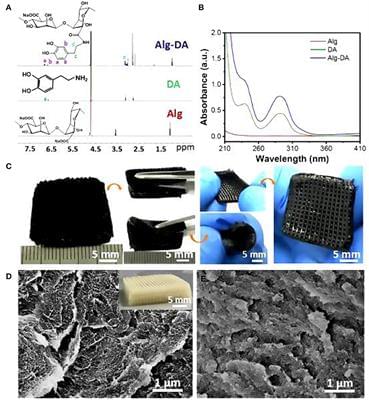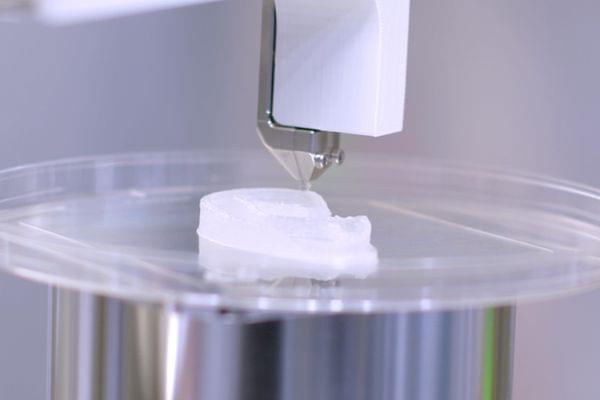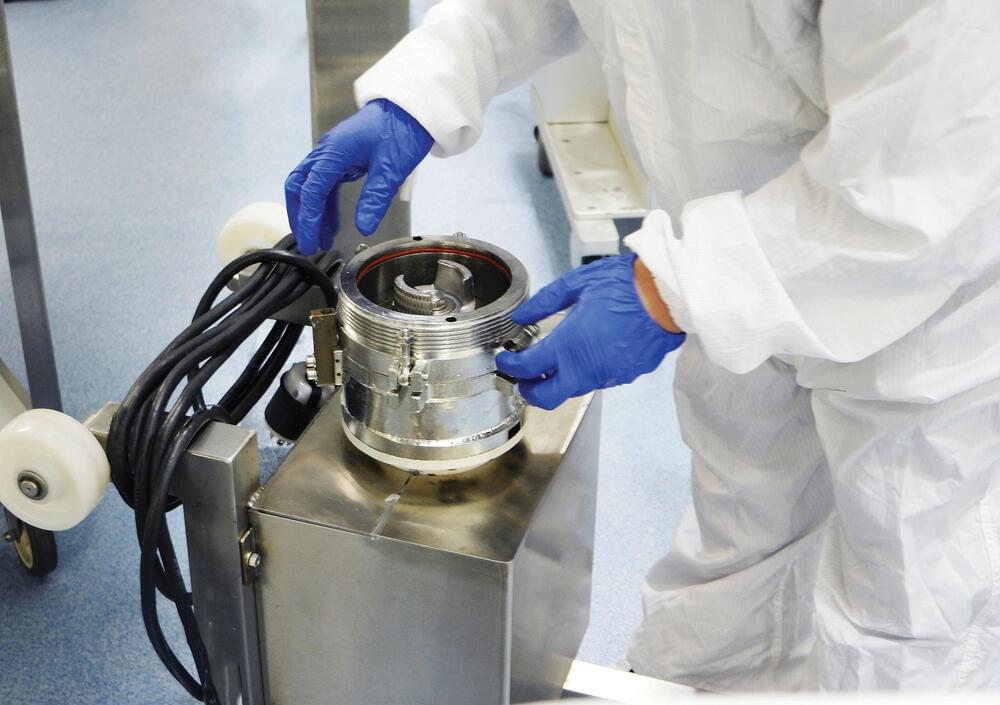Volumetric 3D printing is an exciting technology that could lead to extremely rapid production of 3D printed parts by curing every particle of the object at once. Now, researchers from Utrecht University are applying the process to bioprinting and have 3D printed functioning liver units at centimeter scale in less than 20 seconds. The results were published in Advanced Materials.
Category: bioprinting – Page 7

3D Printing in Breast Reconstruction: From Bench to Bed
Circa 2021:3
Surgical management of breast cancer often results in the absence of the breast. However, existing breast reconstruction methods may not meet the need for a replacement tissue. Tissue engineering with the use of emerging materials offers the promise of generating appropriate replacements. Three-dimensional (3D) printing technology has seen a significantly increased interest and application in medically-related fields in the recent years. This has been especially true in complex medical situations particularly when abnormal or complicated anatomical surgical considerations or precise reconstructive procedures are contemplated. In addition, 3D bio-printing which combines cells with bio-material scaffolds offers an exciting technology with significant applications in the field of tissue engineering. The purpose of this manuscript was to review a number of studies in which 3D printing technology has been used in breast reconstructive surgical procedures, and future directions and applications of 3D bio-printing.
Breast cancer is the most common cancer diagnosed among US women and is second only to lung cancer as a cause of cancer death among women as of 2019. Because ~268,600 (almost six times than DCIS) new cases prove to be an invasive type of breast cancer (1), many women had to choose the removal of the breast, with immediate consideration for a replacement tissue. Although this was satisfactory in many patients, either saline or gel-filled breast implants (2) do carry real risks of complications such as infection, capsular contracture, implant dislocation, or deformities (3, 4). The option of autologous reconstruction can be more texturally natural aesthetically, but it requires a more complex procedure, significant time and expense, and possible muscle weakness or hernia formation at the tissue donor site (5). Tissue engineering intends to address these limitations by combining the 3D printing technology with synthetic or natural structural elements.
Three-dimensional (3D) printing, also known as computer-aided manufacturing (CAM), was based on digital model files using metal powder or plastic and other adhesive materials to construct objects with a computer guided precision, printing layer upon layer. Simplistically, it uses a computer aided design (CAD) program to convert the virtual model of an object into a printable object using an STL (Standard Tessellation Language or STereoLithography) file. The object then gradually and precisely takes shape as each thin layer is added according to the design file, and composed of the desired material for that object in the form of “ink” using the 3D printer. Not only in cases of intraoperative 3D printed models serving as templates, but this technology has extended to implanted scaffolds that have been used to correct defect-specific sites, clearly enhancing patient treatment (6, 7).


Uganda’s New Satellite Contains Equipment to 3D Print Human Tissue in Orbit
With the help of NASA and Japan, Uganda has officially become a spacefaring nation — and its newly-launched PearlAfricaSat-1 craft has some pretty nifty tech onboard.
As the Uganda-based Nile Post reports, the satellite launched out of NASA’s Mid-Atlantic Regional Spaceport facility in Virginia on the morning of November 7 will not only provide important agricultural and security monitoring features for the developing nation, but will also conduct experiments involving the 3D printing of human tissue.
Per the Ugandan news site, the tissues printed on PearlAfricaSat-1 will be used in research into the effects microgravity has on ovary function — and as Quartz notes in its write-up of the NASA and Japan-supported mission, the microgravity aspect of the experiments is key because “bioprinting” human organs is difficult to achieve with Earth’s gravity.

3D printing plant cells shows promise for studying cell function
A new study from North Carolina State University shows a reproducible way of studying cellular communication among varied types of plant cells by “bioprinting” these cells via a 3D printer. Learning more about how plant cells communicate with each other—and with their environment—is key to understanding more about plant cell functions and could ultimately lead to creating better crop varieties and optimal growing environments.
The researchers bioprinted cells from the model plant Arabidopsis thaliana and from soybeans to study not just whether plant cells would live after being bioprinted—and for how long—but also to examine how they acquire and change their identity and function.
“A plant root has a lot of different cell types with specialized functions,” said Lisa Van den Broeck, an NC State postdoctoral researcher who is the first author of a paper describing the work. “There are also different sets of genes being expressed; some are cell-specific. We wanted to know what happens after you bioprint live cells and place them into an environment that you design: Are they alive and doing what they should be doing?”

Using colloidal nanodiscs for 3D bioprinting tissues and tissue models
Extrusion-based 3D printing/bioprinting is a promising approach to generating patient-specific, tissue-engineered grafts. However, a major challenge in extrusion-based 3D printing and bioprinting is that most currently used materials lack the versatility to be used in a wide range of applications.
New nanotechnology has been developed by a team of researchers from Texas A&M University that leverages colloidal interactions of nanoparticles to print complex geometries that can mimic tissue and organ structure. The team, led by Dr. Akhilesh Gaharwar, associate professor and Presidential Impact Fellow in the Department of Biomedical Engineering, has introduced colloidal solutions of 2D nanosilicates as a platform technology to print complex structures.
2D nanosilicates are disc-shaped inorganic nanoparticles 20 to 50 nanometers in diameter and 1 to 2 nanometers in thickness. These nanosilicates form a “house-of-cards” structure above a certain concentration in water, known as a colloidal solution.

When we’ll be able to 3D-print organs and who will be able to afford them
To begin the process of bioprinting an organ, doctors typically start with a patient’s own cells. They take a small needle biopsy of an organ or do a minimally invasive surgical procedure that removes a small piece of tissue, “less than half the size of a postage stamp,” Atala said. “By taking this small piece of tissue, we are able to tease cells apart (and) we grow and expand the cells outside the body.”
This growth happens inside a sterile incubator or bioreactor, a pressurized stainless steel vessel that helps the cells stay fed with nutrients – called “media” – the doctors feed them every 24 hours, since cells have their own metabolism, Lewis said. Each cell type has a different media, and the incubator or bioreactor acts as an oven-like device mimicking the internal temperature and oxygenation of the human body, Atala said.
“Then we mix it with this gel, which is like a glue,” Atala said. “Every organ in your body has the cells and the glue that holds it together. Basically, that’s also called ‘extracellular matrix.’”.
Scientists 3D print human tissue in space
A new bioprinter is proven to work in space. Researchers demonstrated they could 3D print human tissue cells on the International Space Station.

Fluicell launches the Biopixlar AER 3D bioprinter — technical specifications and pricing
Fluicell, a bioprinting firm based in Sweden, has launched its new high-precision 3D printer, the Biopixlar AER.
Intended as a successor to the original Biopixlar, the device is Fluicell’s second single-cell 3D bioprinting system. The company has designed its latest machine to be as compact and accessible as possible, and claims that it’s the world’s first microfluidic bioprinter that fits inside a standard flow hood or biosafety cabinet. This enables users to easily integrate it with other in vitro and 3D cell culture technologies.
Victoire Viannay, CEO of Fluicell, said, “With Biopixlar AER, we have reached a new important milestone and we can now offer a pioneering product, fully tailored to meet current and future needs in the rapidly accelerating life science and research sector.”

Decentralized Manufacturing of Advanced Therapies
Medcalf: Because you’re moving away from the economics of scale to closer to the clinic, the batches are smaller and some of the traditional paradigms for quality assurance, such as proof of sterility, are harder to arrange. Thus, you need to have a manufacturing system that includes quality assurance within the system itself.
Automation is often presented as a way to remove the single largest source of infective risk, i.e. the human operator. For example, the self-sterilizing reusable units being developed at the University of Osaka under Professor Masahiro Kino-oka allow small-scale production with a high degree of confidence in the aseptic management of the environment.
Another challenge is defining a product that has variable characteristics. The main reason for decentralizing is to allow customization to a patient, which means you need to have a hierarchy of levels of specification. For example, with bioprinting, which also produces a customized product, you need to define bulk properties, but you also need to set constraints around how it’s anchored or implanted into the patient.